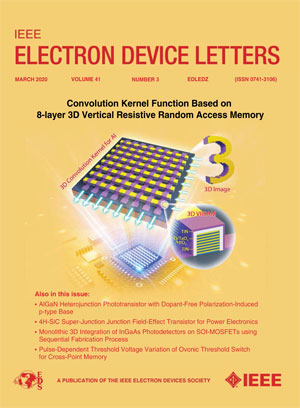Efficient and Stable Perovskite Light-Emitting Diodes Enabled by Oriented Growth Regulation
IF 4.1
2区 工程技术
Q2 ENGINEERING, ELECTRICAL & ELECTRONIC
引用次数: 0
Abstract
Metal halide perovskites have demonstrated remarkable progress in optoelectronic applications, including solar cells and light-emitting diodes (LEDs). However, the long-term stability of perovskite LEDs (PeLEDs) remains a critical challenge, impeding their practical applications and commercialization. Herein, we regulate the growth kinetics of perovskites in liquid-solid stages by introducing 2,3,4,5, 6-pentafluorophenylphosphonic acid (PFBPA) into the precursor solution. The PFBPA molecules will create a protective passivation layer by coordinating with uncoordinated lead (Pb2+) on the perovskite surface, which regulates the growth of perovskite crystals during the liquid-solid stages and results in the formation of uniform perovskite films with reduced grain size. Moreover, the coordination of PFBPA with Pb2+ also improves the moisture resistance of perovskites, favoring the operational stability of devices. The resulting PeLED devices achieved a maximum brightness of 12426 cd m-2, a peak external quantum efficiency (EQE) of 22.6%, and a remarkable operational stability with a half-lifetime exceeding 1187 hours at initial luminance of 100 cd m-2.定向生长调控实现高效稳定的钙钛矿发光二极管
金属卤化物钙钛矿在太阳能电池和发光二极管(led)等光电子应用方面取得了显著进展。然而,钙钛矿led (PeLEDs)的长期稳定性仍然是一个关键挑战,阻碍了它们的实际应用和商业化。在此,我们通过在前驱体溶液中引入2,3,4,5,6 -五氟苯膦酸(PFBPA)来调节钙钛矿在液固阶段的生长动力学。PFBPA分子通过与钙钛矿表面的非配位铅(Pb2+)配合形成保护性钝化层,从而调节钙钛矿晶体在液-固阶段的生长,形成晶粒尺寸减小的均匀钙钛矿膜。此外,PFBPA与Pb2+的配合也提高了钙钛矿的抗湿性,有利于器件的运行稳定性。该器件的最大亮度为12426 cd - m-2,峰值外量子效率(EQE)为22.6%,在初始亮度为100 cd - m-2时,半衰期超过1187小时,具有显著的运行稳定性。
本文章由计算机程序翻译,如有差异,请以英文原文为准。
求助全文
约1分钟内获得全文
求助全文
来源期刊

IEEE Electron Device Letters
工程技术-工程:电子与电气
CiteScore
8.20
自引率
10.20%
发文量
551
审稿时长
1.4 months
期刊介绍:
IEEE Electron Device Letters publishes original and significant contributions relating to the theory, modeling, design, performance and reliability of electron and ion integrated circuit devices and interconnects, involving insulators, metals, organic materials, micro-plasmas, semiconductors, quantum-effect structures, vacuum devices, and emerging materials with applications in bioelectronics, biomedical electronics, computation, communications, displays, microelectromechanics, imaging, micro-actuators, nanoelectronics, optoelectronics, photovoltaics, power ICs and micro-sensors.
 求助内容:
求助内容: 应助结果提醒方式:
应助结果提醒方式:


